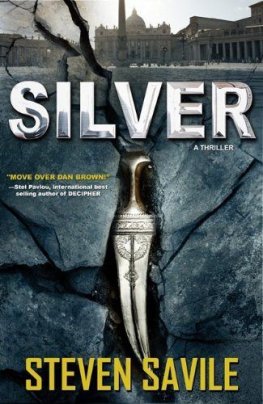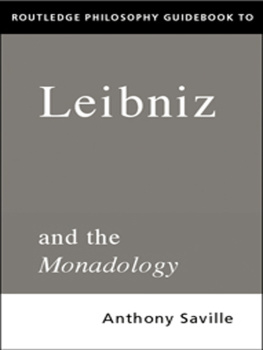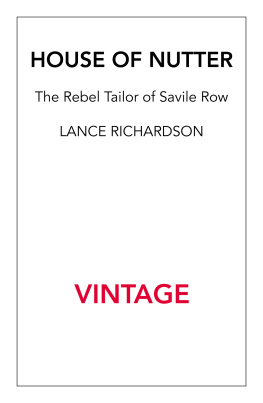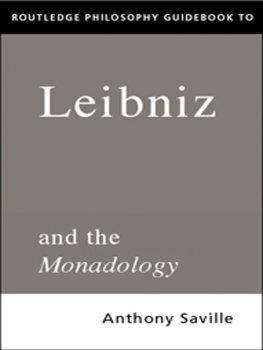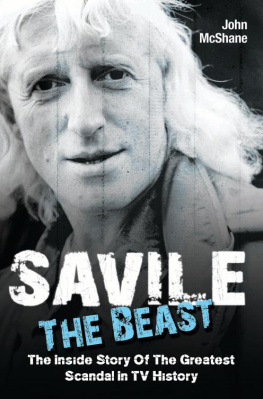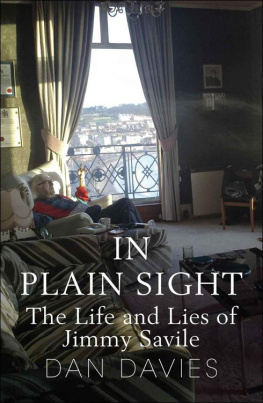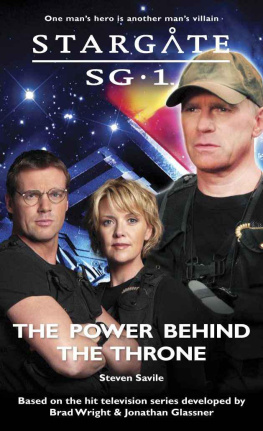BESPOKE
BESPOKE
Savile Row Ripped and Smoothed
Richard Anderson

First published in Great Britain in 2009 by
Simon & Schuster UK Ltd
A CBS COMPANY
Copyright 2009 by Richard Anderson
This book is copyright under the Berne Convention.
No reproduction without permission.
All rights reserved.
The right of Richard Anderson to be identified as the author of this
work has been asserted by him in accordance with sections 77 and 78
of the Copyright, Designs and Patents Act, 1988.
1 3 5 7 9 10 8 6 4 2
Simon & Schuster UK Ltd
1st Floor
222 Grays Inn Road
London
WC1X 8HB
www.simonandschuster.co.uk
Simon & Schuster Australia
Sydney
A CIP catalogue copy for this book is available
from the British Library.
ISBN: 978-1-84737-454-7
eBook ISBN: 978-184737-876-7
Typeset in Palatino by M Rules
Printed in the UK by CPI Mackays, Chatham ME5 8TD
For
Fran
Mum Dad
Tom Molly George Mai
Profile of the Mayfair Man (p. 44) originally appeared in Tailor & Cutter Magazine in 1947. Reprinted by permission of Marie Scott.
Excerpt from Huntsman (p. 177) originally appeared in How to Spend It Magazine, published by the Financial Times, Issue 37, June 1999. Reprinted by permission of the Financial Times.
Excerpt from Kill Poem (p. 187) from OOGA-BOOGA by Frederick Seidel. Copyright 2006 by Frederick Seidel. Reprinted by permission of Farrar, Straus and Giroux, LLC.
The excerpt on p. 200 is from Savile Row Story: An Illustrated History, by Richard Walker, originally published in the UK in 1988 by Prion/Multimedia Books and in the United States in 1989 by Rizzoli. Extensive but unsuccessful efforts were made via the books British and American publishers to identify and contact the original copyright holders to this text. Related parties are asked to contact Simon & Schuster UK with any objections to its inclusion.
The Wife Problem (pp. 21718) was written by H. J. Chappell and originally published in 1947 as part of The Modern Tailor Outfitter and Clothier, edited by Archibald Allon Whife (one-time technical editor of Tailor & Cutter) and published by Caxton Publishing Ltd. Extensive but unsuccessful efforts were made to identify and contact the original copyright holders to this text. Related parties are asked to contact Simon & Schuster UK with any objections to its inclusion.
Contents
Foreword
One of lifes greatest pleasures is to have the opportunity to experience a bespoke suit from a fine English firm such as Richard Andersons.
I first met Richard when he worked at Huntsman, before he opened his own house on Savile Row eight years ago. To be dressed in a suit cut by Richard gives me empowerment and confidence; I show the world my best side in his exquisite bespoke. Winter or summer, the foundation of my wardrobe remains the same: a navy double-breasted, lined in scarlet, cut by Richard himself. It is wearing his work that I receive my highest accolades as a member of the Best-Dressed Hall of Fame.
The time-honoured tradition of bespoke tailoring is an English institution that for centuries has stood for distinction and discretion. Your cutter knows every nuance of fine, handmade tuning in the expert cut of cloth, as well as the ideal shape for your personal wardrobe. To achieve absolute simplicity, as Baudelaire once wrote of true elegance, ones cutter must marshal countless details of individual perspective into the perfect sartorial expression of an accomplished gentleman.
In this compelling personal history of his adventurous rise through the rank and file of Savile Row, Richard tells of one mans journey to establish his own mark through his belief in the highest qualities of fine tailoring, which he upholds not only in London but also in his expansion beyond to the global market. As the age of commuting became the norm, Richard was one of the first to offer personal bi-annual fittings of a customers complete wardrobe from dress suits to business attire to dinner clothes, topcoats, blazers, sport jackets and white tie in all leading capitals of the world. Richard Andersons very special staff members, and often Richard himself, fly to those customers unable to come to London for the critical choice of fabric and required fittings to make the perfect individual suit.
A well-dressed man approaches his wardrobe the way he reads his financial sheets and gives as much concern to his expression of appropriate distinction through individual choice and the finest handmade skills of Richard Andersons cutters and ateliers. As the Comte de Buffon, Georges-Louis Leclerc, said: The style is the man himself. Richard Anderson bespoke affords men the best possible style in a world where fine craftsmanship is not a luxury to the individual man, but a requirement of his very existence.
Andr Leon Talley
September 2009
Editor-at-Large, Vogue USA
Some names have been changed.
Young Richard
Reckoning
My first proper job interview was with the Sun Alliance Insurance Company. I failed to show. I cannot remember exactly why probably in favour of a kickabout with my mates, or furthering my pursuit of Fran OConnor, arguably the prettiest girl in St Michaels sixth form but I do remember the swiftly damning letter I received from the firm, thanking me for having wasted its time. It was an inauspicious beginning.
Lest I botch another good prospect, my father took it upon himself to accompany me personally to my next interview. He had seen the job advertised in the Daily Telegraph just a week before: Wanted, the advertisement read, sixteen- or seventeen-year-old apprentice cutter for Savile Row firm. Energetic... intelligent... smart appearance... I was sceptical (what the hell was a cutter?) but Dad made the call and we were granted an appointment at ten the following Tuesday. I had never heard of Huntsman before. For that matter I am not sure I had ever heard of Savile Row.
This was January 1982, and the night before my interview marked the arrival of Greater Londons worst snowstorm in a decade. Cascading thickly through the night and well into the next morning, the snow seemed to have brought most of Englands train service to a halt. Dad and I managed to squeeze into some standing room on one of the few trains actually making the eighteen-mile journey from Watford Junction to Euston, but by the time we emerged from the Piccadilly underpass into the bright winter glare it was almost midday.
Among the braver members of the West Ends workforce we walked briskly up Regent Street, its dramatic tunnelling curve taking us past the Air Street archway, Aquascutum, the Caf Royal and Austin Reed. My eyes widened at the unfamiliar splendour and soaring architecture I had only been to London a handful of times, and usually with my parents, to visit the shops or see a show but there was no time to linger; we were already two hours late. A left onto Vigo Street followed by a quick right put us at the top end of Savile Row, which except for Dad and me was as empty and bleak as an Alaskan ghost town. Halfway down a series of staid, almost uniform shops, all of them a formidably greyish hue in my memory, stood Number 11, its lower window cloaked with a faded, moss-green curtain. Never before had I approached such an imposing faade. Mounting its snow-swept marble steps on Dads heels I felt a surge of trepidation.
Dad opened the door and we entered.
As we brushed and stamped snow from our shoulders and boots, two stuffed stag heads stared back at us from over an immense fireplace crackling with flames. Before us on the floor lay a vast Persian rug that was slightly threadbare at the edges. Two long, wooden display tables stood to one side, layered with crinkle-edged cloth swatches in countless colours, weights and textures. Towards the back of the room was a buzz of activity phones ringing and people grouped in twos and threes to survey catalogues of yet more fabric, deeply engaged in lively debates concerning the materials sundry qualities and potential.
Next page

